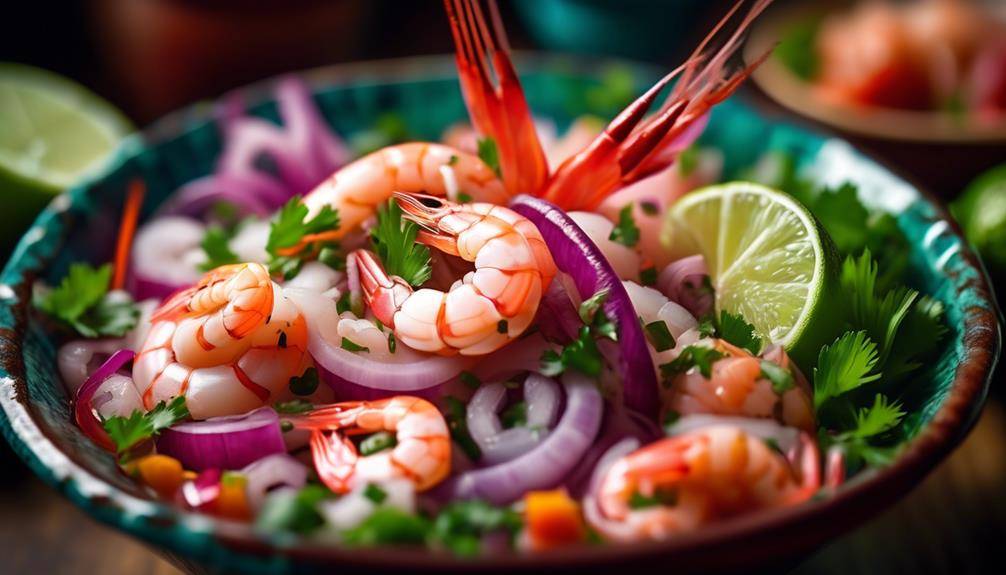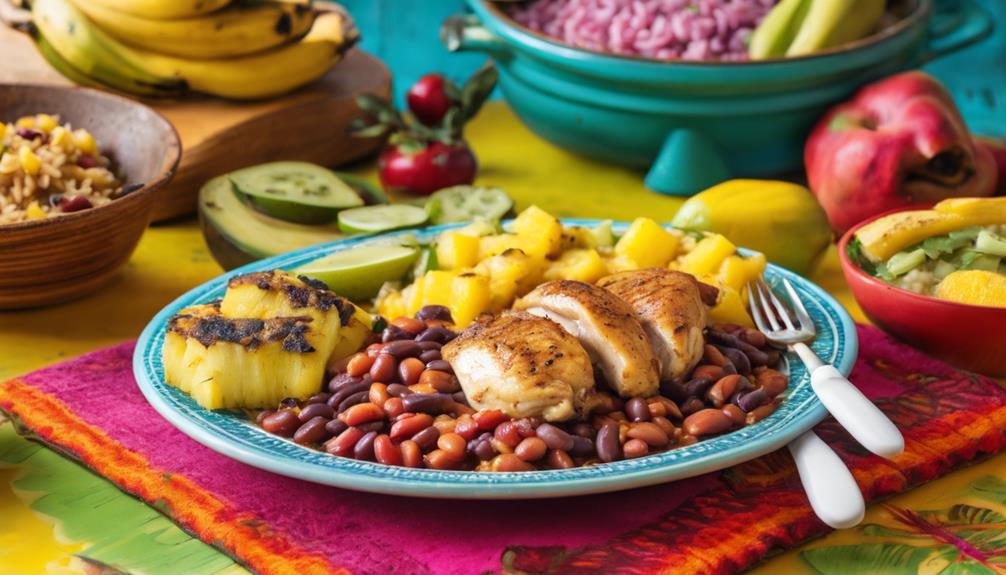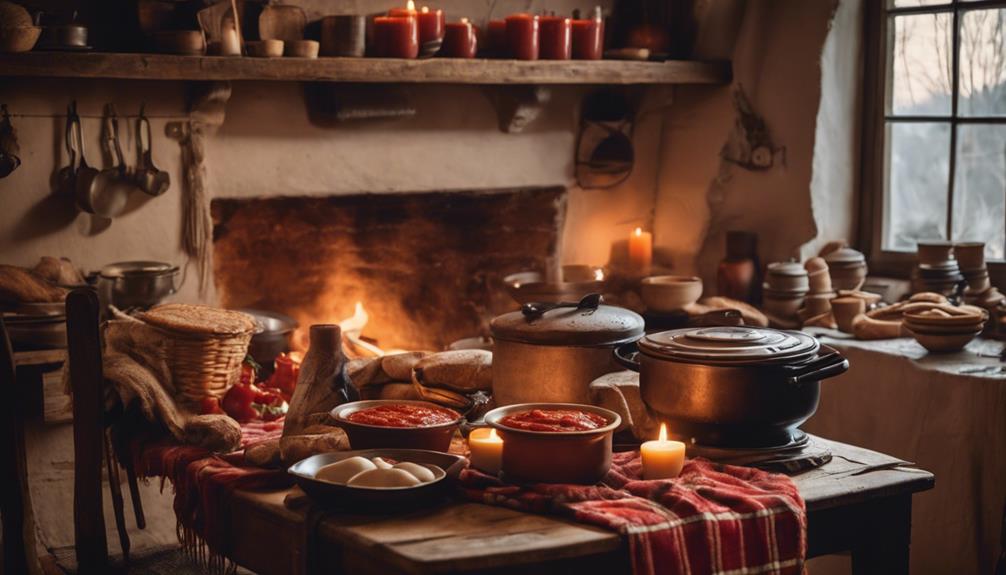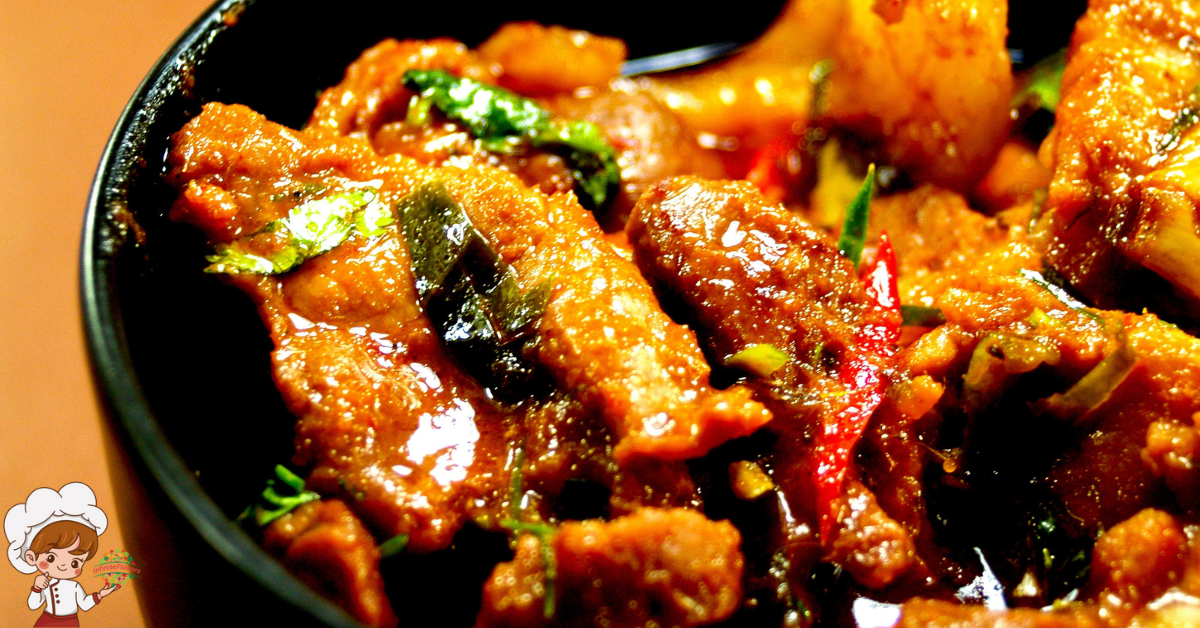Peruvian Cuisine And Its Vibrant Colors
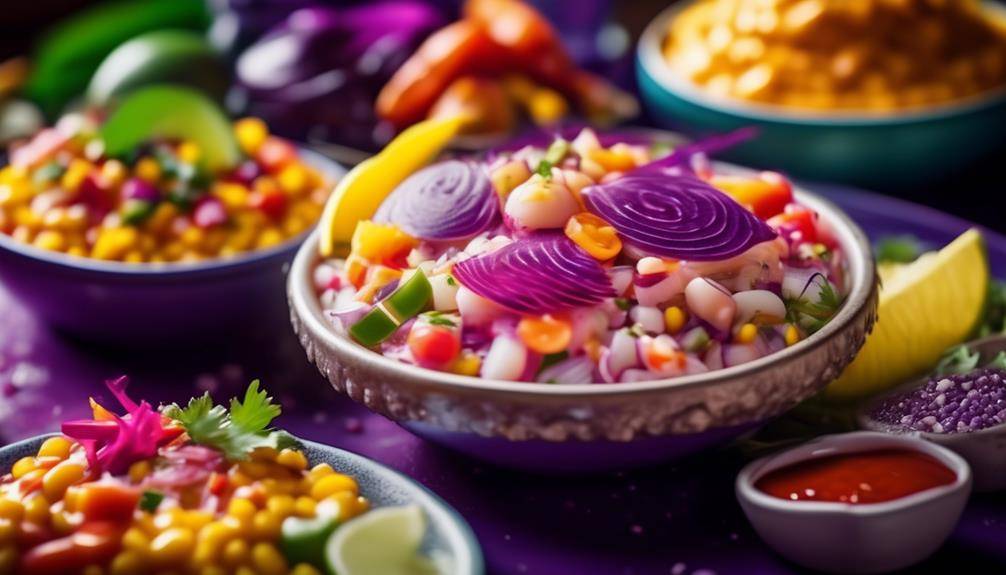
They say, “you eat with your eyes first,” and nowhere is this more true than in the Peruvian Cuisine And Its Vibrant Colors. From the sun-kissed spice of aji amarillo to the bold flavors of Peruvian black mint, the colors found in Peruvian dishes are as enticing as they are visually stunning. But what is it about these vibrant hues that make Peruvian cuisine so unique? And how do they enhance the flavors and overall dining experience? Join us as we explore the significance of color in Peruvian cuisine and unravel the secrets behind its artistic and mouthwatering plating. Get ready to embark on a culinary journey that will leave you craving for more.
The Significance of Color in Peruvian Cuisine
When exploring the vibrant world of Peruvian cuisine, one cannot overlook the significance of color in every dish. The colors in Peruvian cuisine go beyond mere visual appeal; they hold deep cultural significance and are often used to convey messages or symbolize certain elements. Color symbolism plays a crucial role in the culinary traditions of Peru, reflecting the country’s rich history and diverse cultural influences.
In Peruvian cuisine, the use of colors is not arbitrary but carefully chosen to represent different aspects of the culture. For example, the color yellow is often associated with the Inca Empire and represents the golden sun that was worshipped by the ancient civilization. Dishes like causa, a layered potato dish with vibrant yellow aji amarillo sauce, pay homage to this historical connection. The bright orange color in dishes such as ceviche, made with fresh fish marinated in citrus juices, reflects the abundance of seafood found along the Peruvian coastline.
Green, another prominent color in Peruvian cuisine, symbolizes the country’s lush landscapes and fertile valleys. Aji, a spicy green chili pepper, is used in many Peruvian dishes to add a vibrant green color and a distinctive flavor. The traditional dish, lomo saltado, combines strips of beef, onions, tomatoes, and aji amarillo sauce, creating a visually appealing and flavorful dish that represents the fusion of Peruvian and Chinese culinary traditions.
Red, often associated with passion and energy, is used in Peruvian cuisine to evoke a sense of excitement and intensity. The fiery red rocoto pepper, indigenous to Peru, is a key ingredient in dishes like rocoto relleno, a stuffed pepper dish. The red color not only adds a bold visual element but also enhances the spicy flavor that Peruvian cuisine is known for.
A Rainbow of Ingredients in Peruvian Dishes
Get ready to embark on a culinary journey filled with vibrant colors and flavors. Peruvian dishes are known for their colorful vegetable medleys that add a pop of brightness to every plate. From the vibrant spices and herbs used to season the dishes to the eye-catching presentation techniques, Peruvian cuisine truly embraces the concept of a rainbow of ingredients.
Colorful Vegetable Medley
In Peruvian cuisine, a colorful vegetable medley bursts with vibrant hues, adding a visual feast to the already delightful flavors. This dish, known as a colorful vegetable stir fry, showcases the diversity of Peruvian vegetable dishes. Here are some key elements that make this dish a standout:
- A riot of colors: The vegetable medley features a dazzling array of vibrant colors, from the deep red of tomatoes to the bright orange of carrots, and the vibrant green of bell peppers. Each colorful ingredient adds a burst of freshness to the dish.
- A symphony of flavors: The combination of different vegetables creates a harmonious blend of flavors. The sweetness of the carrots balances the tanginess of the tomatoes, while the crispness of the bell peppers adds a satisfying crunch.
- A nutritious powerhouse: Packed with vitamins, minerals, and antioxidants, this colorful vegetable medley is not only visually appealing but also a healthy addition to any meal.
- A versatile dish: Whether served as a side dish or as a main course, this vegetable stir fry can be enjoyed on its own or paired with other Peruvian delicacies, such as quinoa or grilled chicken.
Vibrant Spices and Herbs
With a vibrant array of spices and herbs, Peruvian dishes come alive with a rainbow of flavors that tantalize the taste buds. The vibrant spice blends used in Peruvian cuisine are a testament to the country’s rich culinary heritage. One such blend is aji amarillo, a bright yellow pepper that adds a spicy kick to dishes like ceviche and causa.
Another popular spice is rocoto, a fiery red pepper that gives Peruvian dishes a bold and intense flavor. Traditional herb combinations like huacatay, a black mint with a distinct aroma, and culantro, a pungent herb similar to cilantro, provide a unique taste to Peruvian dishes. These vibrant spices and herbs not only add color to the plate but also elevate the overall dining experience, making Peruvian cuisine truly unforgettable.
Eye-Catching Presentation Techniques
Colorful and visually stunning, Peruvian dishes showcase a vibrant array of ingredients that create a rainbow of flavors on the plate. The art of colorful food presentation is a crucial aspect of Peruvian cuisine. Chefs in Peru have mastered the art of garnishing techniques to enhance the visual appeal of their dishes. From delicate microgreens sprinkled on top to vibrant edible flowers carefully placed, each plate is a work of art.
The use of contrasting colors and textures adds depth and complexity to the presentation. Peruvian chefs also employ creative plating techniques like stacking ingredients and using geometric designs to create visually striking compositions. These eye-catching presentation techniques not only make the dishes Instagram-worthy but also heighten the anticipation and excitement of the diners.
Yellow: Aji Amarillo – The Sun-Kissed Spice
A burst of vibrant yellow awaits you in Peruvian cuisine with the sun-kissed spice known as Aji Amarillo. This golden pepper, with its distinct flavor and fiery kick, holds a special place in Peruvian culinary traditions. Its cultural significance runs deep, as it represents the rich history and diverse flavors of Peruvian cuisine.
Aji Amarillo, also known as the “yellow chili,” is a staple ingredient in many Peruvian dishes. Its bright color adds a captivating visual element to the cuisine, making it as visually appealing as it is delicious. From traditional ceviche to the famous Peruvian chicken dish, Pollo a la Brasa, Aji Amarillo plays a crucial role in creating the vibrant flavors that Peruvian cuisine is renowned for.
But Aji Amarillo is not just about its culinary appeal. It holds a special place in Peruvian culture, symbolizing the sun-kissed landscapes and warm climate of the country. In fact, the name “Aji Amarillo” translates to “yellow pepper” in English, further emphasizing the color and flavor it brings to Peruvian dishes.
The cultural significance of Aji Amarillo can also be seen in the way it is used in traditional celebrations. During festivals and special occasions, Aji Amarillo is often incorporated into dishes as a symbol of good luck and prosperity. It adds a touch of vibrancy to the festivities and reinforces the connection between food and culture in Peruvian society.
Purple: The Many Shades of Peruvian Potatoes
As you explore the vibrant world of Peruvian cuisine, you cannot overlook the array of purple potatoes that grace the country’s culinary landscape. These rich potato varieties come in a spectrum of shades, ranging from deep violet to lavender hues. Beyond their stunning appearance, these potatoes offer a wealth of nutritional benefits and boast a culinary versatility that is sure to impress even the most discerning palates.
Rich Potato Varieties
With their vibrant hues ranging from deep indigo to pale lavender, the rich potato varieties found in Peru showcase a stunning array of colors that are as captivating as they are delicious. These potatoes have not only culinary uses but also hold historical significance in Peruvian cuisine. Some of the rich potato varieties you can find in Peru are:
- Purple Majesty: Known for its dark purple skin and flesh, this potato is not only visually striking but also offers a nutty flavor, making it perfect for roasting or mashing.
- Purple Peruvian: This potato has a dark purple skin and a vibrant purple flesh. Its creamy texture and earthy taste make it ideal for soups or salads.
- Purple Fiesta: With its deep purple skin and pale purple flesh, this potato is versatile and can be used in a variety of dishes, from fries to stews.
- Purple Viking: This potato has a marbled purple and white skin with a creamy white flesh. Its mild flavor and firm texture make it a great choice for boiling or baking.
These rich potato varieties not only add a pop of color to your plate but also bring a depth of flavor and history to Peruvian cuisine.
Nutritional Benefits
As we delve into the nutritional benefits of the vibrant purple potato varieties found in Peru, prepare to discover a colorful world of flavors and health benefits waiting to nourish your body and delight your taste buds. These purple potatoes are not only visually stunning, but they also pack a powerful nutritional punch. Rich in antioxidants, vitamins, and minerals, they offer a range of health benefits.
These potatoes are a great source of dietary fiber, which aids in digestion and helps maintain a healthy weight. They are also high in potassium, which promotes heart health and helps regulate blood pressure. In addition to their nutritional benefits, purple potatoes have a long history of culinary uses in Peruvian cuisine. They are a staple in many traditional dishes and hold cultural significance, representing the diversity and vibrancy of Peruvian food culture. Incorporating these purple potatoes into your diet is not only a flavorful experience, but also a nutritious one.
Culinary Versatility
Purple potatoes in Peruvian cuisine offer a kaleidoscope of flavors and textures, making them a versatile ingredient that adds a vibrant touch to any dish. These potatoes, with their rich purple hue, have been a staple in Peruvian cuisine for centuries and are a true testament to the culinary versatility of the region. Influenced by the diverse cultural influences that have shaped Peru’s cuisine, purple potatoes can be found in a variety of dishes, from traditional stews and soups to modern fusion creations.
Their earthy, nutty flavor pairs well with both savory and sweet ingredients, allowing chefs to experiment and create unique flavor profiles. Whether roasted, mashed, or used as a colorful garnish, purple potatoes bring an element of surprise and visual appeal to every plate.
Red: Rocoto – The Fiery Peruvian Pepper
The Rocoto pepper, known for its fiery heat and vibrant red color, is a staple ingredient in Peruvian cuisine. This powerful pepper is a favorite among Peruvian chefs and home cooks alike, thanks to its unique flavor profile and versatile culinary uses.
In Peruvian cuisine, rocoto peppers are used in a variety of dishes to add a fiery kick and a touch of vibrant red color. They are often used in marinades, sauces, and salsas, where their intense heat can be balanced with other ingredients. The rocoto pepper is also a key ingredient in the popular Peruvian dish called rocoto relleno, which features the pepper stuffed with a mixture of meat, vegetables, and spices.
While the rocoto pepper is primarily known for its fiery heat, it also offers a range of health benefits. Like other chili peppers, rocoto peppers are rich in capsaicin, a compound known for its anti-inflammatory and pain-relieving properties. Capsaicin has also been shown to boost metabolism and aid in weight loss. Additionally, rocoto peppers are a good source of vitamin C, which is important for immune function and collagen production.
It is important to note that rocoto peppers are extremely hot and should be used with caution, especially for those who are not accustomed to spicy foods. However, for those who can handle the heat, the rocoto pepper adds a bold and fiery flavor to any dish, making it a beloved ingredient in Peruvian cuisine. So, next time you want to spice up your meal, reach for the rocoto pepper and experience the vibrant flavors of Peru.
Green: Huacatay – The Aromatic Herb
Huacatay, the vibrant green aromatic herb of Peruvian cuisine, adds a unique and enticing flavor to a variety of dishes. This herb, also known as Peruvian black mint, is an essential ingredient in many traditional Peruvian recipes. Its distinct aroma and taste bring a refreshing and herbaceous note to the culinary landscape of Peru. Here are some reasons why huacatay is a prized herb in Peruvian cuisine:
- Versatile Use: Huacatay is used in various dishes, from soups and stews to sauces and marinades. Its bold flavor enhances the taste of meat, poultry, and seafood, making it a versatile herb that can be incorporated into a wide range of recipes.
- Distinctive Flavor: The flavor of huacatay is often described as a combination of mint, basil, and tarragon, with a hint of citrus. It brings a unique taste to dishes, adding depth and complexity to the overall flavor profile.
- Huacatay Recipes: Some popular dishes that feature huacatay include causa, a layered potato dish, and ocopa, a spicy sauce made with huacatay, peanuts, and cheese. These recipes showcase the herb’s ability to elevate the flavors of traditional Peruvian dishes.
- Huacatay Health Benefits: Besides its culinary uses, huacatay also offers several health benefits. It is rich in antioxidants, which help protect the body against oxidative stress. Additionally, it has been used in traditional medicine to treat digestive issues and promote overall well-being.
Orange: Lucuma – The Exotic Superfruit
Get ready to discover the vibrant world of Lucuma, the exotic superfruit that is sure to captivate your taste buds and boost your health. From its numerous health benefits to its versatile culinary uses, Lucuma is a true gem of Peruvian cuisine. But its significance extends beyond the plate, as Lucuma holds a special place in Peruvian culture, symbolizing fertility, abundance, and even divine connections. So let’s embark on this journey and uncover the wonders of this orange-hued fruit.
Health Benefits of Lucuma
Discover the incredible health benefits that come with indulging in the exotic superfruit of Lucuma, a vibrant orange fruit known for its extraordinary nutritional properties. Lucuma is not only delicious but also packed with essential nutrients that can boost your overall well-being. Here are some of the amazing health benefits of Lucuma:
- Rich in antioxidants: Lucuma is a great source of antioxidants, which help protect your cells from damage caused by free radicals and reduce the risk of chronic diseases.
- Supports digestion: The high fiber content in Lucuma promotes healthy digestion and prevents constipation.
- Boosts the immune system: Lucuma is loaded with vitamin C, which strengthens the immune system and helps fight off infections.
- Regulates blood sugar levels: Lucuma has a low glycemic index, making it a good option for those with diabetes or looking to manage their blood sugar levels.
Incorporating Lucuma into your diet can not only add a burst of flavor to your dishes but also provide numerous health benefits. Give this exotic superfruit a try and experience its remarkable nutritional properties firsthand.
Culinary Uses of Lucuma
Now that you’re aware of the incredible health benefits of Lucuma, let’s explore its culinary uses and discover how this exotic superfruit can elevate your dishes with its vibrant orange color and unique flavor profile. Lucuma has long been a staple in Peruvian culinary traditions, adding a burst of color and a hint of sweetness to a variety of dishes. Its rich, creamy texture makes it a perfect ingredient for desserts like ice cream, cakes, and pies. You can also use it to make delicious smoothies, milkshakes, and even cocktails. The versatility of Lucuma allows it to be incorporated into both sweet and savory dishes, making it a must-have ingredient for any creative cook.
Additionally, Lucuma’s natural sweetness means you can reduce the amount of sugar in your recipes, making it a healthier alternative to traditional sweeteners. So go ahead and add a touch of Peru to your culinary creations with the vibrant and nutritious Lucuma!
Lucuma in Peruvian Culture
Lucuma, the exotic superfruit, holds a special place in Peruvian culture with its vibrant orange color and unique flavor profile. Its cultural significance can be seen in various aspects of Peruvian life, from traditional festivities to culinary traditions. Here are four key elements that highlight the importance of lucuma in Peruvian culture:
- Symbol of fertility: Lucuma is often associated with fertility and is believed to bring good fortune to couples trying to conceive. It is commonly used in fertility rituals and celebrations.
- Traditional desserts: Lucuma is a key ingredient in many traditional Peruvian desserts, such as lucuma ice cream and lucuma mousse. These sweet treats showcase the rich and creamy flavor of the fruit.
- Artistic inspiration: The vibrant orange color of lucuma has inspired many Peruvian artists. It is often depicted in paintings, textiles, and pottery, adding a burst of color and beauty to Peruvian art.
- Cultural pride: Lucuma is considered one of Peru’s national treasures, representing the country’s rich culinary heritage. Its inclusion in traditional recipes and its cultural significance make it a source of pride for Peruvians.
Lucuma’s cultural significance and its role in traditional lucuma recipes demonstrate the deep-rooted connection between this exotic superfruit and Peruvian culture.
Blue: The Ocean’s Influence on Peruvian Cuisine
With its vibrant blue hues, the ocean has a captivating influence on the rich and diverse flavors found in Peruvian cuisine. The color blue holds a special significance in Peruvian art, symbolizing the vastness and majesty of the Pacific Ocean that borders the country. This same influence extends to the culinary world, where the use of blue corn adds a unique touch to traditional Peruvian dishes.
Blue corn, a variety of maize native to the Andean region, is a staple ingredient in Peruvian cuisine. Its deep blue color not only adds visual appeal to dishes but also enhances their flavors. Blue corn is used in a variety of preparations, such as tortillas, bread, and beverages. The corn is ground into flour and mixed with other ingredients to create a dough that is then cooked or baked. The resulting products have a distinct nutty flavor and a slightly sweeter taste compared to regular corn.
One popular dish that showcases the influence of the ocean is ceviche. This iconic Peruvian dish consists of fresh raw fish or seafood marinated in citrus juices, typically lime or lemon, and seasoned with onions, chili peppers, and cilantro. The vibrant blue hues of the ocean are reflected in the vibrant colors of the dish, with the blue corn tortilla chips serving as a perfect accompaniment.
The ocean’s influence on Peruvian cuisine goes beyond just the visual aesthetics. The bounty of the Pacific Ocean provides a wide variety of seafood options, such as anchovies, mussels, and octopus, which are integral to many traditional Peruvian dishes. The flavors of the sea infuse the cuisine, creating a unique and unforgettable culinary experience.
Brown: The Earthy Flavors of Peruvian Cacao
Peruvian cacao, with its rich earthy flavors, takes center stage in the diverse and tantalizing world of Peruvian cuisine. This humble ingredient, derived from the cacao tree, has been cultivated in Peru for centuries, resulting in cacao beans that are renowned for their exceptional quality and taste. The earthy cacao flavors found in Peruvian cuisine are truly a treat for the senses, offering a depth and complexity that is unmatched.
When exploring the brown hues of Peruvian cacao, you will discover a myriad of culinary delights that showcase its unique flavors. From velvety smooth chocolate desserts to savory dishes infused with cacao, the possibilities are endless. Here are four ways in which Peruvian cuisine brings out the best in earthy cacao flavors:
- Cacao-infused sauces: Peruvian chefs use cacao as a base for rich, flavorful sauces that complement a variety of dishes. The earthy undertones of cacao add depth and richness to sauces, creating a harmonious balance of flavors.
- Cacao-spiced meats: Peruvian cuisine is known for its vibrant spice blends, and cacao is no exception. The earthy flavors of cacao are often combined with spices like cumin and chili to create a tantalizing rub for meats. The result is a mouthwatering dish that is both savory and subtly sweet.
- Cacao in traditional beverages: Cacao is not only used in desserts and savory dishes but also in traditional Peruvian beverages. From hot chocolate infused with spices to the beloved chicha morada, a purple corn drink with cacao, these beverages offer a delightful way to savor the earthy flavors of Peruvian cacao.
- Cacao-inspired desserts: Peruvian desserts are renowned for their indulgent flavors, and cacao plays a starring role in many of them. From luscious chocolate truffles to creamy cacao mousse, these desserts showcase the earthy richness of Peruvian cacao in all its glory.
In Peruvian cuisine, the earthy flavors of cacao bring depth, complexity, and a touch of sweetness to a wide array of dishes. Whether it’s a savory main course or a decadent dessert, the brown hues of Peruvian cacao are sure to captivate your taste buds and leave you craving for more.
Pink: Chicha Morada – The Refreshing Purple Corn Drink
As you continue your culinary journey through the vibrant hues of Peruvian cuisine, immerse yourself in the refreshing world of chicha morada, a captivating purple corn drink that will awaken your senses with its unique pink hues and tantalizing flavors. Chicha morada has a rich history that dates back to the ancient Inca civilization. The Incas revered purple corn for its vibrant color and believed it to have healing properties. They would boil the corn with various fruits and spices to create a delicious and nutritious beverage.
The process of making chicha morada begins with boiling purple corn kernels, along with pineapple peels, cinnamon, and cloves. This mixture is then simmered for several hours until the flavors meld together, resulting in a vibrant pink liquid. The drink is then strained and chilled before being served with a squeeze of lime juice.
Aside from its enchanting color, chicha morada is also known for its numerous health benefits. Purple corn is rich in anthocyanins, which are antioxidants that help protect the body against inflammation and oxidative stress. These antioxidants have been linked to a reduced risk of chronic diseases such as heart disease and cancer. Chicha morada is also packed with vitamins and minerals, including vitamin C, potassium, and iron.
In addition to its health benefits, chicha morada is a refreshing and thirst-quenching beverage, perfect for hot summer days. Its vibrant pink color and sweet yet tangy flavor make it a popular choice among locals and tourists alike. So, as you embark on your culinary adventure in Peru, make sure to indulge in the captivating world of chicha morada and savor its unique flavors and health benefits.
White: Quinoa – The Ancient Superfood
Why has quinoa gained such popularity as an ancient superfood in Peruvian cuisine? The answer lies in its versatility and numerous health benefits. Quinoa, a grain-like seed native to the Andean region, has been a staple in Peruvian diets for thousands of years. It is not only delicious but also packed with nutrients that make it a true superfood. Here are four reasons why quinoa has become a beloved ingredient in Peruvian cuisine:
- Rich in protein: Quinoa is one of the few plant-based sources that provide all essential amino acids, making it a complete protein. This makes it an excellent choice for vegans and vegetarians looking to meet their protein requirements.
- Gluten-free: Quinoa is naturally gluten-free, making it a safe and healthy alternative for those with gluten sensitivities or celiac disease.
- High in fiber: Quinoa is a great source of dietary fiber, promoting healthy digestion and preventing constipation. It also helps regulate blood sugar levels and keeps you feeling fuller for longer.
- Versatile and delicious: Quinoa’s mild, nutty flavor and fluffy texture make it a versatile ingredient in both sweet and savory dishes. From salads and stir-fries to desserts and breakfast bowls, there is an endless array of quinoa recipes to explore.
In addition to these benefits, quinoa is also rich in vitamins and minerals such as magnesium, iron, and zinc. Its inclusion in Peruvian cuisine showcases the country’s commitment to using nutritious, locally-sourced ingredients. Whether you are looking to improve your health or simply enjoy a delicious meal, quinoa is a fantastic addition to any diet. So, why not try incorporating this ancient superfood into your own culinary adventures?
Black: The Bold Flavors of Peruvian Black Mint
With its rich history of incorporating nutritious ingredients into its cuisine, Peruvian culture continues to captivate taste buds with the bold flavors of Peruvian black mint. This unique herb, known as huacatay in Peru, is a staple in Peruvian cooking and adds a distinctive taste and vibrant color to dishes.
Peruvian black mint is known for its intense aroma and flavor. It has a bold, earthy taste with hints of citrus and mint, making it a perfect ingredient to enhance the flavors of various dishes. Whether used in marinades, sauces, or stews, this herb adds a depth of flavor that is both captivating and unforgettable.
One of the most popular dishes that feature Peruvian black mint is the traditional Peruvian dish, causa. Causa is a layered potato dish that is typically filled with avocado, chicken, or seafood. The addition of black mint to the mashed potatoes gives it a unique flavor profile, elevating the dish to new heights.
In addition to its bold flavors, Peruvian black mint also brings vibrant colors to the table. Its deep green leaves add a pop of color to any dish, making it visually appealing and appetizing. From bright green ceviche to vibrant green sauces, the addition of black mint not only enhances the taste but also creates a visually stunning presentation.
Peruvian black mint is truly a culinary gem that showcases the bold flavors and vibrant colors of Peruvian cuisine. Its unique taste and visual appeal make it a must-try ingredient for anyone looking to explore the rich flavors of Peru. So next time you’re in the mood for something bold and vibrant, be sure to add a touch of Peruvian black mint to your dish.
Mixing Colors: Artistic Plating in Peruvian Cuisine
To create a visually captivating dining experience, Peruvian cuisine takes artistic plating to new heights by expertly mixing vibrant colors on the plate. Each dish is meticulously crafted, utilizing various artistic plating techniques that not only showcase the culinary skills of the chef but also pay homage to the cultural significance of vibrant colors in Peruvian cuisine.
Here are four artistic plating techniques that reflect the cultural significance of vibrant colors in Peruvian cuisine:
- *Contrasting Colors*: Peruvian chefs skillfully juxtapose contrasting colors on the plate to create a visually striking presentation. For example, bright yellow corn can be paired with deep purple potatoes, creating a beautiful contrast that catches the eye.
- *Color Symbolism*: Colors in Peruvian cuisine often hold symbolic meanings. For instance, the color red is associated with passion and love, so a vibrant red sauce drizzled over a dish may represent a chef’s passion for their craft and a desire to delight their diners.
- *Harmonious Color Combinations*: Peruvian chefs understand the harmony of colors and use this knowledge to create visually pleasing compositions. They carefully select ingredients that complement each other in color, such as pairing green avocado with pink shrimp, creating a balanced and aesthetically pleasing dish.
- *Colorful Garnishes*: Peruvian cuisine embraces the use of vibrant garnishes to add pops of color to the plate. From purple edible flowers to bright orange rocoto peppers, these garnishes not only enhance the visual appeal of the dish but also add subtle flavors that complement the main ingredients.
Peruvian Cuisine And Its Vibrant Colors; Frequently Asked Questions
What Are Some Common Spices Used in Peruvian Cuisine?
In Peruvian cuisine, spices play a vital role in adding unique flavors and cultural significance. Some common spices used include aji amarillo, cumin, paprika, and oregano. These spices bring a burst of vibrant colors to the dishes, enhancing the overall culinary experience.
How Do Peruvian Dishes Incorporate the Colors of Their Ingredients?
Incorporating vibrant colors into Peruvian dishes is a key aspect of their cuisine. Colors are important because they represent the diversity of ingredients and the cultural significance of each dish. Traditional Peruvian recipes explore the use of natural pigments to enhance the visual appeal of the food.
What Are the Health Benefits of the Different Colored Ingredients in Peruvian Cuisine?
Incorporating vibrant colored ingredients in Peruvian cuisine brings a myriad of health benefits. From the rich antioxidants in purple potatoes to the immune-boosting properties of yellow peppers, these colors are not just visually appealing but also nutritious. Culinary techniques like roasting and grilling further enhance these vibrant hues, making Peruvian dishes a feast for both the eyes and the body.
Are There Any Traditional Peruvian Dishes That Combine Multiple Vibrant Colors?
There are several traditional Peruvian dishes that combine multiple vibrant colors. Peruvian cuisine’s use of colorful ingredients in its dishes creates visually stunning and appetizing meals that are a feast for the eyes.
How Does the Artistic Plating of Peruvian Cuisine Enhance the Dining Experience?
When it comes to Peruvian cuisine, the artistic plating techniques really enhance your dining experience. The vibrant colors not only make the food visually appealing, but also reflect the cultural significance of these colors in Peruvian traditions.
Conclusion
In conclusion, the vibrant colors of Peruvian cuisine not only add visual appeal to the dishes, but also represent the rich cultural heritage and diversity of ingredients found in the country. From the sun-kissed yellow of aji amarillo to the bold flavors of black mint, each color tells a story and contributes to the unique flavor profiles of Peruvian dishes. So, next time you indulge in Peruvian cuisine, savor not only the taste but also the beautiful colors that make it truly special.



